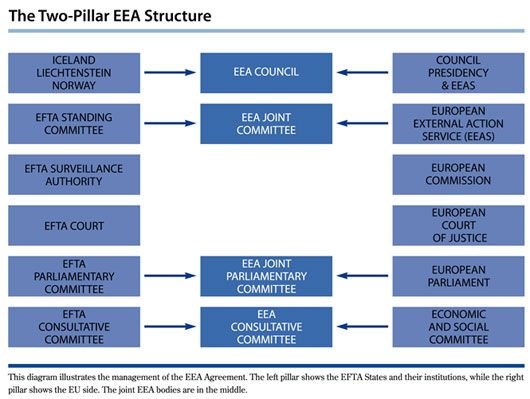EEA institutions and bodies
Article | Last updated: 02/02/2022 | Ministry of Foreign Affairs
The administration and management of the EEA is shared between the EU and the EEA Efta states. The institutional framework established to manage the EEA Agreement is known as the two-pillar system. The EEA Efta institutions and EU institutions form the two pillars, and there are also four joint EEA bodies.
The four joint EEA bodies, in which representatives of the EEA Efta states and representatives of the EU meet, are: the EEA Council and the EEA Joint Committee, which can be seen as forming a bridge between the two pillars, the EEA Joint Parliamentary Committee, and the EEA Consultative Committee (a forum for cooperation between the social partners).
The most important institutions in the Efta pillar are the Efta Standing Committee, the Efta Surveillance Authority and the Efta Court. There are also two advisory committees: the Efta Parliamentary Committee and the Efta Consultative Committee.

Efta
The European Free Trade Association (Efta) was founded in 1960 to promote free trade and economic integration between its members. Today, there are four Efta member states: Norway, Iceland, Liechtenstein, and Switzerland. More information can be found on the Efta website.
The EEA Council is the highest political body for cooperation between the EU and the EEA Efta states. The EEA Council provides political impetus for the development of the EEA Agreement and assesses the overall functioning of the Agreement. More information can be found here.
EEA Joint Committee
The EEA Joint Committee is responsible for the ongoing management of the EEA Agreement. Its main task is to take decisions concerning the incorporation of EU legislation into the EEA Agreement. More information can be found here.
EEA Joint Parliamentary Committee
The EEA Joint Parliamentary Committee is an advisory body that provides input through reports and resolutions. Participation in the committee gives representatives of the EEA Efta states access to more detailed information on EU/EEA issues and provides them with a formal channel of communication to the European Parliament. More information can be found here.
EEA Consultative Committee
The EEA Consultative Committee is an advisory body made up of members of the Efta Consultative Committee and the European Economic and Social Committee. It is a forum for cooperation between the social partners in the EEA Efta states and those in the EU. It provides input through reports and resolutions, in the same way as the EEA Joint Parliamentary Committee. More information can be found here.
Standing Committee of the Efta States
The Standing Committee of the Efta States handles politically important EEA matters. Its most important function is to serve as a forum for consultations between the EEA Efta states prior to meetings in the EEA Joint Committee and the EEA Council. More information can be found here.
Efta Surveillance Authority
The Efta Surveillance Authority is responsible for monitoring implementation and compliance with EEA rules in the individual EEA Efta states, just as the European Commission is responsible for ensuring that EU member states comply with their obligations under EU legislation. More information can be found here.
Efta Court
The Efta Court plays a role vis-à-vis the EEA Efta states that is comparable to the role played by the European Court of Justice vis-à-vis the EU member states. In its deliberations, the Efta Court attaches great importance to European Court of Justice case law. More information can be found here.
Efta Parliamentary Committee
The Efta Parliamentary Committee is an advisory body. The members of the Efta Parliamentary Committee also participate in the EEA Joint Parliamentary Committee. More information can be found here.
Efta Consultative Committee
The Efta Consultative Committee is an advisory body where the Efta social partners can provide input on the development of Efta cooperation. More information can be found here.